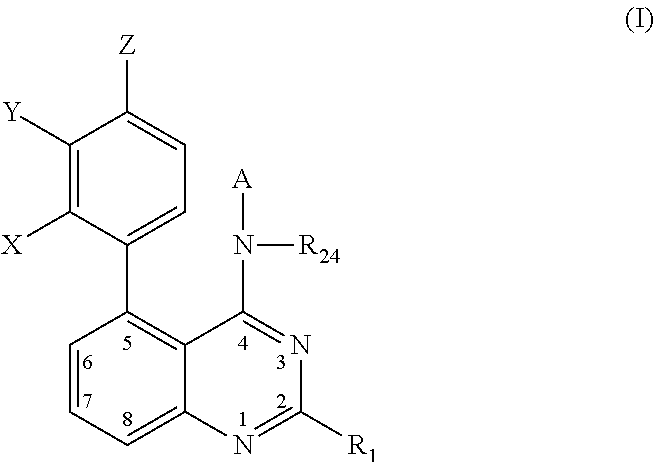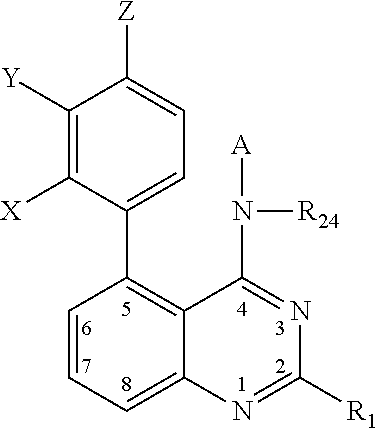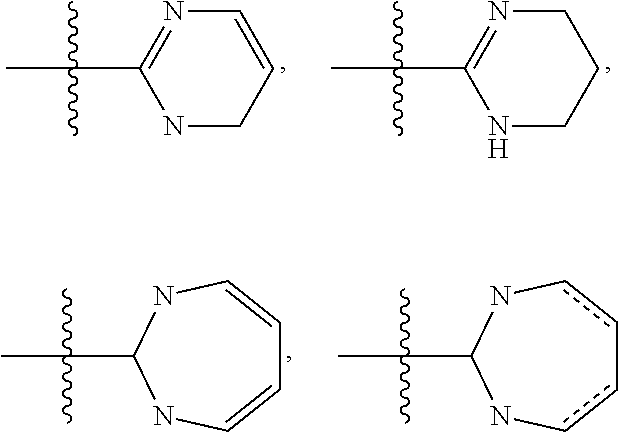Quinazolines as potassium ion channel inhibitors
a potassium ion channel inhibitor and ion channel technology, applied in the field of useful ion channel inhibitors, can solve the problems of neurotoxicity, gastrointestinal discomfort, nephrotoxicity,
- Summary
- Abstract
- Description
- Claims
- Application Information
AI Technical Summary
Benefits of technology
Problems solved by technology
Method used
Image
Examples
example 1
Step 4. Example 1
[0858]
[0859]A stirred suspension of 5-bromo-N-(pyridin-2-ylmethyl)-2-(pyrimidin-5-yl)quinazolin-4-amine (1.0 g, 2.5 mmol), phenylboronic acid (0.46 g, 3.8 mmol) and potassium carbonate (1.0 g, 7.6 mmol) in dimethoxyethane-water (3-1, 10 mL) was degassed and charged with tetrakistriphenylphosphene palladium (0.14 g, 0.12 mmol). The reaction mixture was then heated to 90° C. where it stirred for 16 h under a nitrogen atmosphere. After this time, the reaction mixture was quenched with water (5 mL) and then extracted with ethyl acetate (3×25 mL). The combined organic extracts were dried and then concentrated to yield the crude product. The crude product was purified by preparative TLC using chloroform and methanol (95:5) as the solvent system to yield Example 1 (40 mg, 4% yield). 1H NMR (400 MHz, DMSO-d6, δ): 5.01 (d, J=5.6 Hz, 2H); 7.27 (t, J=4.0 Hz, 1H); 7.41-7.56 (m, 5H); 7.66-7.79 (m, 4H); 7.91 (d, J=6.8 Hz, 1H); 8.42 (d, J=8 Hz, 1H); 8.55 (d, J=4.8 Hz, 1H); 9.23 (s...
example 2
Step 4. Example 2
[0872]
[0873]To a solution of 4-chloro-5-phenyl-2-(trifluoromethyl)quinazoline (200 mg, 0.648 mmol) in THF (15 mL) was added triethylamine (0.172 mL, 1.231 mmol). Upon completion of addition, the reaction mixture was stirred and pyridin-2-ylmethanamine was added (0.080 mL, 0.777 mmol). The resulting reaction mixture was stirred at room temperature for 1 h and then filtered. The filtrate was concentrated under reduced pressure to yield a residue. The residue was purified by flash chromatography on silica gel eluting with 0-75% ethyl acetate / hexanes to yield Example 2 (217 mg, 88% yield) as a white solid. 1H NMR (400 MHz, chloroform-d) ppm 8.20 (1H, d, J=4.55 Hz), 7.99 (1H, d, J=8.34 Hz), 7.78 (1H, t, J=7.71 Hz), 7.59 (1H, t, J=7.58 Hz), 7.42-7.54 (5H, m), 7.35 (1H, d, J=7.33 Hz), 7.03-7.22 (3H, m), 4.69 (2H, d, J=4.04 Hz). LCMS Method D: retention time 0.90 min [M+1]=381.
example 3
2-Cyclopropyl-5-phenyl-N-(pyridin-2-ylmethyl)quinazolin-4-amine
[0874]
[0875]To a mixture of zinc bromide (64.9 mg, 0.288 mmol) and 1,1′-bis(diphenylphosphino)ferrocene-palladium(II)dichloride dichloromethane complex (5.89 mg, 7.21 μmol) was added anhydrous THF (0.3 mL). Upon completion of addition, the mixture was cooled to −78° C. Once at the prescribed temperature, cyclopropyl magnesium bromide (0.288 mL, 0.144 mmol) was added dropwise and the mixture was stirred at −78° C. for 15 min. At the conclusion of this period, a solution of 2-chloro-5-phenyl-N-(pyridin-2-ylmethyl)quinazolin-4-amine (50 mg, 0.144 mmol) in anhydrous THF (1.5 mL) was added. The resulting mixture was stirred at −78° C. for 1 h and then allowed to warm to room temperature where it stirred for 18 h. After this time, the reaction mixture was diluted with saturated NH4Cl (5 mL) and the aqueous layer extracted with ethyl acetate (3×20 mL). The organic portions were combined and washed with saturated NaCl, dried ove...
PUM
 Login to View More
Login to View More Abstract
Description
Claims
Application Information
 Login to View More
Login to View More - R&D
- Intellectual Property
- Life Sciences
- Materials
- Tech Scout
- Unparalleled Data Quality
- Higher Quality Content
- 60% Fewer Hallucinations
Browse by: Latest US Patents, China's latest patents, Technical Efficacy Thesaurus, Application Domain, Technology Topic, Popular Technical Reports.
© 2025 PatSnap. All rights reserved.Legal|Privacy policy|Modern Slavery Act Transparency Statement|Sitemap|About US| Contact US: help@patsnap.com



